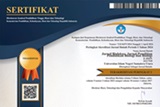Systematic Review: Efektivitas Ideonella sakaiensis dan Chlamydomonas reinhardtii sebagai Agen Biodegradasi Plastik Berbahan Dasar PET
Abstract
Bakteri Ideonella sakaiensis dan microalga Chlamydomonas reinhardtii dapat mendegradasi plastik PET (Poly-ethylene terephthalate) dengan mensintesiskan enzim PETase. Tujuan penelitian ini adalah untuk mengetahui efektivitas dari bakteri Ideonella sakaiensis dan Chlamydomonas reinhardtii sebagai agen biodegradasi plastik berbahan dasar PET. Penelitian ini merupakan systematic review, yang dilakukan dengan membandingkan dan menganalisis artikel-artikel yang diambil dari database digital seperti Springer Link dan Semanthic Schoolar. Artikel–artikel yang telah dicari dengan keyword yang telah ditentukan, kemudian dieksklusi sesuai dengan parameter yang ditetapkan, sehingga didapat 2 artikel rujukan. Hasil review menunjukkan bakteri I. sakaiensis mampu mendegradasi PET menjadi MHET (Monoterephtalic Hydroxyethyl Terephtalate) yang lebih dominan dibanding BHET (Bis-hydroxyethyl Terephtalate) & TPA (Terephthalate Acid), sedangkan C. reinhardtii mendegradasikan PET menjadi TPA. Bakteri I. sakaiensis memerlukan waktu 18 jam untuk dapat mendegradasi 30 % dari PET film sedangkan C.reinhardtii memerlukan waktu 4 minggu untuk dapat mendegradasi 35,17% dari PET powder. Kedua mikroorganisme tersebut memiliki keefektifan yang berbeda dalam setiap parameter, yaitu hasil degradasi dan lama waktu pendegradasian.
Keywords
Full Text:
PDFReferences
Chia, W. Y., Ying Tang, D. Y., Khoo, K. S., Kay Lup, A. N., & Chew, K. W. (2020). Nature’s fight against plastic pollution: Algae for plastic biodegradation and bioplastics production. Environmental Science and Ecotechnology, 4(100065) 1-10.
https://doi.org/10.1016/j.ese.2020.100065
Damayanti, Hanif, M., & Arnesa, W.W. (2015). Pengaruh rasio berat katalis terhadap berat plastik bekas pet pada proses pirolisis berkatalis dan karakteristik produk cair yang dihasilkan. Seminar Nasional Sains & Teknologi VI Lembaga Penelitian dan Pengabdian Universitas Lampung, 375–385.
de Castro, A. M., Carniel, A., Nicomedes Junior, J., da Conceição Gomes, A., & Valoni, É. (2017). Screening of commercial enzymes for poly (ethylene terephthalate) (PET) hydrolysis and synergy studies on different substrate sources. Journal of Industrial Microbiology and Biotechnology, 44(6), 835–844. https://doi.org/10.1007/s10295-017-1942-z
Farzi, A., Dehnad, A., & Fotouhi, A. F. (2019). Biodegradation of polyethylene terephthalate waste using Streptomyces species and kinetic modeling of the process. Biocatalysis and Agricultural Biotechnology, 17, 25–31.
https://doi.org/10.1016/j.bcab.2018.11.002
Fitriyano, G. (2019). Tinjauan potensi pemanfaatan botol bekas berbahan Polyethylene Terephthalate (PET) di Indonesia. Eksergi, 16(1), 18-24. https://doi.org/10.31315/e.v16i1.2747
Han, X., Liu, W., Huang, J. W., Ma, J., Zheng, Y., Ko, T. P., Xu, L., Cheng, Y. S., Chen, C. C., & Guo, R. T. (2017). Structural insight into catalytic mechanism of PET hydrolase. Nature Communications, 8(2106), 1-6. https://doi.org/10.1038/s41467-017-02255-z
Karuniastuti, N. (2013). Bahaya Plastik terhadap Kesehatan dan Lingkungan. Swara Patra: Majalah Pusdiklat Migas, 3(1), 6–14.
Kawai, F., Kawabata, T., & Oda, M. (2019). Current knowledge on enzymatic PET degradation and its possible application to waste stream management and other fields. Applied Microbiology and Biotechnology, 103(11), 4253–4268. https://doi.org/10.1007/s00253-019-09717-y
Khan, K. S., Kunz, R., Kleijnen, J., & Antes, G. (2003). Five steps to conducting a systematic review. Journal of the Royal Society of Medicine, 96(3), 118-121. https://doi.org/10.1258/jrsm.96.3.118
Kim, J. W., Park, S. Bin, Tran, Q. G., Cho, D. H., Choi, D. Y., Lee, Y. J., & Kim, H. S. (2020). Functional expression of polyethylene terephthalate-degrading enzyme (PETase) in green microalgae. Microbial Cell Factories, 19(1), 1–9.
https://doi.org/10.1186/s12934-020-01355-8
Knott, B. C., Erickson, E., Allen, M. D., Gado, J. E., Graham, R., Kearns, F. L., Pardo, I., Topuzlu, E., Anderson, J. J., Austin, H. P., Dominick, G., Johnson, C. W., Rorrer, N. A., Szostkiewicz, C. J., Copié, V., Payne, C. M., Woodcock, H. L., Donohoe, B. S., Beckham, G. T., & McGeehan, J. E. (2020). Characterization and engineering of a two-enzyme system for plastics depolymerization. Proceedings of the National Academy of Sciences of the United States of America. https://doi.org/10.1073/pnas.2006753117
Mittal, A., Soni, R. K., Dutt, K., & Singh, S. (2010). Scanning electron microscopic study of hazardous waste flakes of polyethylene terephthalate (PET) by aminolysis and ammonolysis. Journal of Hazardous Materials, 178(1–3), 390–396. https://doi.org/10.1016/j.jhazmat.2010.01.092
Moog, D., Schmitt, J., Senger, J., Zarzycki, J., Rexer, K. H., Linne, U., Erb, T., & Maier, U. G. (2019). Using a marine microalga as a chassis for polyethylene terephthalate (PET) degradation. Microbial Cell Factories, 18(1), 1–15. https://doi.org/10.1186/s12934-019-220-z
Mueller, R. J. (2006). Biological degradation of synthetic polyesters-Enzymes as potential catalysts for polyester recycling. Process Biochemistry, 41(10), 2124–2128. https://doi.org/10.1016/j.procbio.2006.05.018
Nurhati, I. S. (2020). Peningkatan Sampah Plastik dari Belanja Online dan Delivery Selama PSBB. LIPI.
Sasso, S., Stibor, H., Mittag, M., & Grossman, A. R. (2018). The natural history of model organisms from molecular manipulation of domesticated Chlamydomonas reinhardtii to survival in nature. eLife. eLife, 7, e39233. https://doi.org/10.7554/eLife.39233.
Seo, H., Kim, S., Son, H. F., Sagong, H. Y., Joo, S., & Kim, K. J. (2019). Production of extracellular PETase from Ideonella sakaiensis using sec-dependent signal peptides in E. coli. Biochemical and Biophysical Research Communications, 508(1), 250-255.
https://doi.org/10.1016/j.bbrc.2018.11.087
Shinshi, O., & Kogo, H. (1980). Effects of phthalic acid monoesters on mouse testes. Toxicology Letters, 6(4–5), 239–242. https://doi.org/10.1016/0378-4274(80)90126-5
Tanasupawat, S., Takehana, T., Yoshida, S., Hiraga, K., & Oda, K. (2016). Ideonella sakaiensis sp. nov., isolated from a microbial consortium that degrades poly(ethylene terephthalate). International Journal of Systematic and Evolutionary Microbiolog,. 66(8), 2813-2818.
https://doi.org/10.1099/ijsem.0.001058
Thiruvenkatachari, R., Kwon, T. O., Jun, J. C., Balaji, S., Matheswaran, M., & Moon, I. S. (2007). Application of several advanced oxidation processes for the destruction of terephthalic acid (TPA). Journal of Hazardous Materials, 142(1-2), 308-314. https://doi.org/10.1016/j.jhazmat.2006.08.023
Triyaningsih, Sartijo, & Prayitno, S. B. (2008). Patogenisitas Aeromonas hydrophila yang diisolasi dari lele dumbo (Clarias gariepinus) yang berasal dari boyolali. Journal of Aquaculture Management and Technology, 3(2), 11–17.
http://ejournal-s1.undip.ac.id/index.php/jfpik
Warlina, L. (2019). Pengelolaan sampah plastik untuk mitigasi bencana lingkungan. Peran Matematika, Sains & Teknologi dalam Kebencanaan.
Yan, N., Fan, C., Chen, Y., & Hu, Z. (2016). The potential for microalgae as bioreactors to produce pharmaceuticals. International Journal of Molecular Sciences, 17(6), 962.
https://doi.org/10.3390/ijms17060962
Yang, Y., Yang, J., & Jiang, L. (2016). Comment on "a bacterium that degrades and assimilates poly(ethylene terephthalate) ". Science, 353(6301), 759.
https://doi.org/10.1126/science.aaf8305
Yoshida, S., Hiraga, K., Takehana, T., Taniguchi, I., Yamaji, H., Maeda, Y., Toyohara, K., Miyamoto, K., Kimura, Y., & Oda, K. (2016). A bacterium that degrades and assimilates poly(ethylene terephthalate). Science, 351(6278), 1196–1199.
https://doi.org/10.1126/science.aaf8305
DOI: http://dx.doi.org/10.30821/biolokus.v4i1.901
Refbacks
- There are currently no refbacks.
Copyright (c) 2021 Jurnal Biolokus: Jurnal Penelitian Pendidikan Biologi dan Biologi
indexed by :












